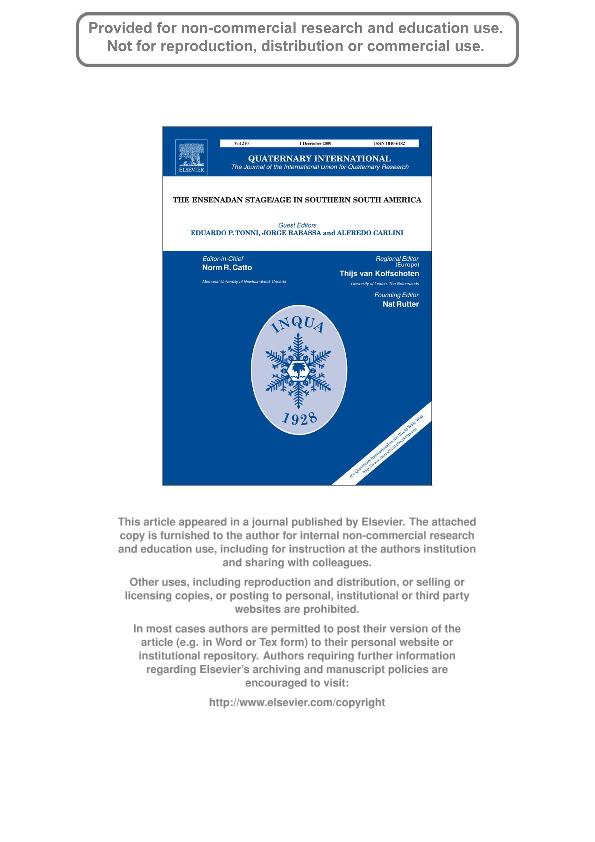Mostrar el registro sencillo del ítem
dc.contributor.author
Tonni, Eduardo Pedro

dc.contributor.author
Soibelzon, Esteban

dc.contributor.author
Cione, Alberto Luis

dc.contributor.author
Carlini, Alfredo Armando

dc.contributor.author
Scillato, Gustavo Juan

dc.contributor.author
Zurita, Alfredo Eduardo

dc.contributor.author
Paredes Rios, Freddy

dc.date.available
2018-03-02T19:14:39Z
dc.date.issued
2009-12
dc.identifier.citation
Tonni, Eduardo Pedro; Soibelzon, Esteban; Cione, Alberto Luis; Carlini, Alfredo Armando; Scillato, Gustavo Juan; et al.; Preliminar correlation of the Pleistocene sequences of the Tarija valley (Bolivia) with the Pampean chronological standard; Pergamon-Elsevier Science Ltd; Quaternary International; 210; 1-2; 12-2009; 57-65
dc.identifier.issn
1040-6182
dc.identifier.uri
http://hdl.handle.net/11336/37693
dc.description.abstract
Most of the mammal collections of the Pleistocene from the Tarija valley (Bolivia) lack precise stratigraphic data. Some fossil collections were made under stratigraphic control but have not been described. However, mammals were used for correlation and comparison with the pattern established for the Pampean region of Argentina. The bearing units have been referred either to the Ensenadan and Bonaerian stages, the "Belgranan", the Ensenadan, or the Lujanian in a broad sense, corresponding to the middle-upper Pleistocene or the upper Pleistocene. Studies during the last twenty five years accomplished by American authors and based on magnetostratigraphy and absolute dating suggest that the Tarija sequence corresponds to the Ensenadan (early-middle Pleistocene) of the Pampean standard. Recently, Italian scientists, based on radiometric dating, discarded this age and considered that the whole sequence belongs to the late Pleistocene. New biostratigraphic and systematic studies allowed the recognition of Glyptodon munizi, Arctotherium angustidens, and Hippidion devillei, exclusive taxa of the Mesotherium cristatum Biozone, the biostratigraphic base for the Ensenadan of the Pampean region. However, collections include mostly putative endemic species or those characteristic of the Equus (Amerhippus) neogaeus Biozone, the biostratigraphic base for the Lujanian of the Pampean area. In sum, from a biostratigraphic point of view, the Tarija sequence has taxa from the lower to middle Pleistocene (Ensenadan) and the upper Pleistocene-lower Holocene (Lujanian) of the Pampean area. From a paleofaunistic standpoint, the association recovered from the Tarija valley shows significant differences with the typical Pampean association. The high frequency of remains of Gomphotheriidae and Equidae and, in lower proportion, of Hydrochoeriidae and Tapiridae, are noteworthy. Members of these two latter families are restricted today to warm and wet climates. Most Glyptodontidae records belong to Glyptodon, and in the Pampean region this family is much more diversified.
dc.format
application/pdf
dc.language.iso
eng
dc.publisher
Pergamon-Elsevier Science Ltd

dc.rights
info:eu-repo/semantics/openAccess
dc.rights.uri
https://creativecommons.org/licenses/by-nc-sa/2.5/ar/
dc.subject
Tarija Valley
dc.subject
Pampean Chronological Satndard
dc.subject
Correlation
dc.subject
Pleistocene Sequences
dc.subject.classification
Meteorología y Ciencias Atmosféricas

dc.subject.classification
Ciencias de la Tierra y relacionadas con el Medio Ambiente

dc.subject.classification
CIENCIAS NATURALES Y EXACTAS

dc.title
Preliminar correlation of the Pleistocene sequences of the Tarija valley (Bolivia) with the Pampean chronological standard
dc.type
info:eu-repo/semantics/article
dc.type
info:ar-repo/semantics/artículo
dc.type
info:eu-repo/semantics/publishedVersion
dc.date.updated
2017-12-04T17:42:09Z
dc.journal.volume
210
dc.journal.number
1-2
dc.journal.pagination
57-65
dc.journal.pais
Países Bajos

dc.journal.ciudad
Amsterdam
dc.description.fil
Fil: Tonni, Eduardo Pedro. Universidad Nacional de la Plata. Facultad de Ciencias Naturales y Museo. División Paleontología Vertebrados; Argentina
dc.description.fil
Fil: Soibelzon, Esteban. Universidad Nacional de la Plata. Facultad de Ciencias Naturales y Museo. División Paleontología Vertebrados; Argentina. Consejo Nacional de Investigaciones Científicas y Técnicas; Argentina
dc.description.fil
Fil: Cione, Alberto Luis. Consejo Nacional de Investigaciones Científicas y Técnicas; Argentina. Universidad Nacional de la Plata. Facultad de Ciencias Naturales y Museo. División Paleontología Vertebrados; Argentina
dc.description.fil
Fil: Carlini, Alfredo Armando. Universitat Zurich. Instituto Palaontologisches Institut And Museum; Suiza. Universidad Nacional de la Plata. Facultad de Ciencias Naturales y Museo. División Paleontología Vertebrados; Argentina
dc.description.fil
Fil: Scillato, Gustavo Juan. Consejo Nacional de Investigaciones Científicas y Técnicas; Argentina. Universidad Nacional de la Plata. Facultad de Ciencias Naturales y Museo. División Paleontología Vertebrados; Argentina
dc.description.fil
Fil: Zurita, Alfredo Eduardo. Consejo Nacional de Investigaciones Científicas y Técnicas. Centro Científico Tecnológico Conicet - Nordeste. Centro de Ecología Aplicada del Litoral. Universidad Nacional del Nordeste. Centro de Ecología Aplicada del Litoral; Argentina
dc.description.fil
Fil: Paredes Rios, Freddy. Universidad Autónoma Juan Misael Saracho; Bolivia
dc.journal.title
Quaternary International

dc.relation.alternativeid
info:eu-repo/semantics/altIdentifier/doi/http://dx.doi.org/10.1016/j.quaint.2009.06.015
dc.relation.alternativeid
info:eu-repo/semantics/altIdentifier/url/https://www.sciencedirect.com/science/article/pii/S1040618209001943
Archivos asociados
